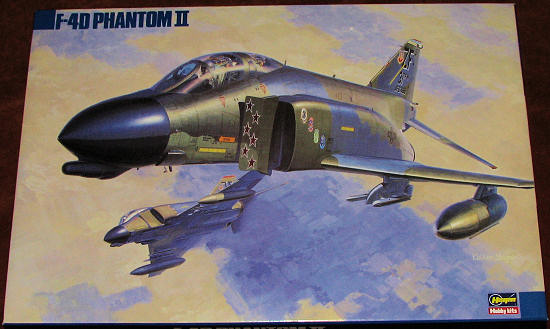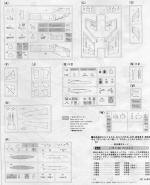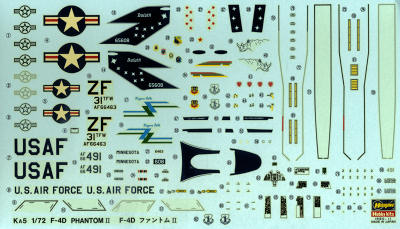
Hasegawa 1/72 F-4D Phantom II
| KIT # | 04105 (Ka5) |
| PRICE: | @$25.00 |
| DECALS: | See review |
| REVIEW & | |
| NOTES: | Second generation basic boxing |

| HISTORY |
To most knowledgeable and intelligent people, the finest jet inthe last 55 years is the F-4 Phantom II. Those lacking proper perception willundoubtedly differ in this matter, however, it isn't too late to come to yoursenses! :o)
Other than perhaps the Mig-17 or Mig-21, no other post-Koreanwar jet has been built in greater numbers. Certainly no other non-Sovietdesigned aircraft. There must have been a reason for it. It certainly isn'tsimplicity or ease of maintenance. The Phantom was one of the last Westernfighters where the airframe was designed first and then room was found for otherequipment. Nowadays, ease of maintenance is as important as any other factor. Itcertainly wasn't designed to be stealthy. Nothing like two smoke trailsfollowing several tons of hurtling metal to make yourself visible! It alsowasn't designed to be quiet. If you have ever been around the beast withoutproper hearing protection, your ears will definitely be ringing.
What made it such a success is that it was able to perform avariety of missions and perform them all well. Probably your first decentmulti-mission aircraft. It was an interceptor, a (unwilling) dogfighter, asuperb ground attack aircraft, a night fighter, a level bomber, a SAMsuppression aircraft, and a blast to fly. Before that, aircraft were generallyspecialized. After the Phantom, there were still purposefully built aircraft,but it lead the way to today's multi-mission aircraft.
It was one of the few combat types flown by the US Navy, Marinesand Air Force at the same time. I'm sure that if the Army was allowed fixed wingsupersonic combat jets, that it would have flown them as well. Nearly all whoflew it loved it, and so did many of those who fixed it (albeit several yearsafter the type left service!). The final tally of F-4s, including those built inthe UK and those built in Japan was 5,027.
| THE KIT |
 Hasegawa's 1/72 third generation F-4 series has been around since the mid/late 1980s. Indeed, this second generation basic boxing of this series is dated 1990 and unlike the first generation boxing, is strictly F-4Ds where the initial one including F-4C markings. Really, there is almost no external difference between the two types with the more square box on the IR seeker fairing being the major external clue. All the changes were internal as the USAF adopted more USAF-specific avionics for the D model. This increased its capability and made it a better fighter-bomber.
Hasegawa's 1/72 third generation F-4 series has been around since the mid/late 1980s. Indeed, this second generation basic boxing of this series is dated 1990 and unlike the first generation boxing, is strictly F-4Ds where the initial one including F-4C markings. Really, there is almost no external difference between the two types with the more square box on the IR seeker fairing being the major external clue. All the changes were internal as the USAF adopted more USAF-specific avionics for the D model. This increased its capability and made it a better fighter-bomber.
The kit comes with two different types of IR seeker, an early and a late version for the D. By sanding one of the boxes from the underside of the seeker, you can do an F-4C, but you will need photos to be sure you get all the other antennas or lack thereof, correct. The kit also comes with the unslatted, reinforced tail plane which is typical of later F-4Ds as the earlier ones did not have the reinforcement.
Other things to watch for. The kit recommends only the F-15 style centerline tank. This may not be correct for the box art plane so check references. Same goes for the IR seeker with only the early one being shown. The Hill Grey II plane probably had the additional antenna suite given with the optional seeker.
The rest of the kit is pretty standard stuff. 'Thick' wing with wider main tires, five piece cockpit canopy set. Decals for instruments and the USAF cockpit with two control sticks. This version uses the short burner cans. Of course, no weapons so break out the weapons set and you will need to match the appropriate Sidewinders to the aircraft you are building.
 If you choose to use the kit decals, these are the standard ones that are a bit thick, do not like most setting solutions and have off-white whites. Markings are provided for three planes. One is a Euro 1 camouflaged plane that was flown by Ritchie and DeBellevue and has six kill markings. The plane did not get all those kills with these guys, though. Its final active life was with the 31st TFW and is in the boss bird markings of that unit. This aircraft is now displayed outside at the USAF Academy. The next option is an ADC grey airplane with the 179 FIS, Minnesota ANG. This is also a MiG killer with one star for the splitter plate. The final option is a Hill Grey II painted plane with the 136 FIS, New York ANG at Niagara Falls in its final scheme. This latter one has the appropriate 'rhino' marking on the nose as carried by all the unit's planes. What you need to do when using the kit decals is to be sure to use very warm tohot water to soften them so they will stick.
If you choose to use the kit decals, these are the standard ones that are a bit thick, do not like most setting solutions and have off-white whites. Markings are provided for three planes. One is a Euro 1 camouflaged plane that was flown by Ritchie and DeBellevue and has six kill markings. The plane did not get all those kills with these guys, though. Its final active life was with the 31st TFW and is in the boss bird markings of that unit. This aircraft is now displayed outside at the USAF Academy. The next option is an ADC grey airplane with the 179 FIS, Minnesota ANG. This is also a MiG killer with one star for the splitter plate. The final option is a Hill Grey II painted plane with the 136 FIS, New York ANG at Niagara Falls in its final scheme. This latter one has the appropriate 'rhino' marking on the nose as carried by all the unit's planes. What you need to do when using the kit decals is to be sure to use very warm tohot water to soften them so they will stick.
| CONCLUSIONS |
If you have built any of this generation of Hasegawa Phantom, you will find nothing different in the build. Because of all the differences, you will find a lot of inserts, making the kit rather fiddly. You will also find the intakes to be probably the most difficult fitting portion of the kit. However, the end result is the most accurate F-4 in this scale. If you are a fan of this aircraft, this is what you should build.
August 2012
Review kit courtesy of me.
If you would like your product reviewed fairly and fairly quickly, please contactthe editor or see other details in the